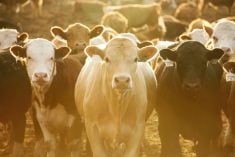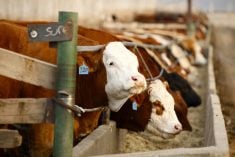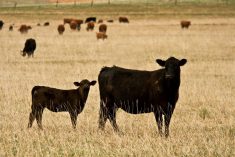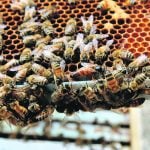For the week ending Saturday, western Canadian feeder cattle markets were relatively unchanged from seven days earlier.
The finishing feedlot operator appears to be dominating the feeder market across all weight categories. Ontario interest was creeping all the way into Alberta, especially for Limousin-type genetics. There were limited numbers on offer in Manitoba and Saskatchewan this past week. This caused U.S. buyers to stretch arms into Alberta’s main markets. In most cases, the buyer shopping for grass cattle cannot compete with the finishing feedlot operator and simply backs away at the higher levels. The discount for fleshier-type yearlings has narrowed due to the tighter supply situation. October feeder cattle futures continue to trade at a $32 premium to the nearby May contract. This has encouraged feedlot operators to secure ownership sooner rather than later.
Read Also

U.S. grains: Soy futures post biggest monthly gain in nearly five years on China trade optimism
U.S. soybean futures climbed to a 15-month high and posted their biggest monthly gain in nearly five years on Friday following a rally fueled by the prospect of revived exports to China.
South of Edmonton, larger-frame Simmental blended steers with medium flesh on light grain ration with full health data averaging a shade under 900 lbs. dropped the gavel at $261. In the Red Deer region, a larger group of optimal-frame mixed heifers carrying very light butter with full health records set the scale at 865 lbs. and notched the price board at $262. In southern Alberta, tan steers with medium flesh levels weighing 825 lbs. were bid up to $289.
At Lloydminster, a smaller group of silver steers weighing 740 lbs. sold for $327 and a handful of Charolais-based heifers weighing 760 lbs. silenced the crowd at $277.
East of Saskatoon, a small group of large-frame black steers averaging 615 lbs. reached up to $327. In central Saskatchewan, a larger group of tan mixed heifers reported at 620 lbs. set the bar at $305. In southern Alberta, Simmental-based steers weighing 640 lbs. were valued at $332 and tan heifers averaging 600 lbs. were valued at $320.
In central Saskatchewan, a smaller group of Angus-based steers weighing 530 lbs. traded hands at $360 while their lighter sisters averaging 520 lbs. pulled buying interest up to $328. In southern Alberta, tan steers weighing 540 lbs. sold for $366 and red steers weighing 460 lbs. scaled fresh heights at $389.
It’s that time of year when weather forecasts are having a larger influence on the grain, oilseed and cattle markets. Central Alberta and Saskatchewan are expected to receive timely rains this week which will enhance yield forecasts for wheat and barley crops. It takes more than one rain to rejuvenate pastures but cow-calf producers are relieved in the short term. Drier conditions and high forage costs have thrown a wrench into expansionary plans for the cow-calf operator. The number of bred cows and cow-calf pairs on the market has exceeded expectations. The beef cow slaughter is also running higher than earlier projections.
— Jerry Klassen is president and founder of Resilient Capital, specializing in proprietary commodity futures trading and market analysis. Jerry consults with feedlots on risk management and writes a weekly cattle market commentary. He can be reached at 204-504-8339 or via his website at ResilCapital.com.













